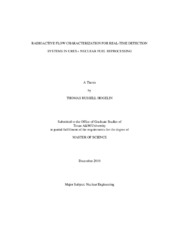| dc.description.abstract | The reprocessing of used nuclear fuel requires the dissolution and separation of
numerous radioisotopes that are present as fission products in the fuel. The leading
technology option in the U.S. for reprocessing is a sequence of processing methods
known as UREX+ (Uranium Extraction ). However, an industrial scale facility
implementing this separation procedure will require the establishment of safeguards and
security systems to ensure the protection of the separated materials. A number of
technologies have been developed for meeting the measurement demands for such a
facility. This project focuses on the design of a gamma detection system for taking
measurements of the flow streams of such a reprocessing facility.
An experimental apparatus was constructed capable of pumping water spiked
with soluble radioisotopes under various flow conditions through a stainless steel coil
around a sodium iodide (NaI) detector system. Experiments were conducted to
characterize the impact of flow rate, pipe air voids, geometry, and radioactivity dilution
level on activity measurements and gamma energy spectra. Two coil geometries were used for these experiments, using 0.5 in stainless steel pipe wound into a coil with a 6
inch diameter; the first coil was 5.5 revolutions tall and the second coil was 9.5
revolutions tall. The isotopes dissolved in the flowing water were produced at the Texas A&M Nuclear Science Center via neutron activation of chromium, gold, cerium, and ytterbium nitrate salts. After activation, the salts were dissolved in distilled water and inserted into the radioactive flow assembly for quantitative measurements. Flow rate variations from 100 to 2000 ml/min were used and activity dilution levels for the experiments conducted were between 0.02 and 1.6 μCi/liter. Detection of system transients was observed to improve with decreasing flow rate. The detection limits observed for this system were 0.02 μCi/liter over background, 0.5% total activity change in a pre-spiked system, and a dilution change of 2% of the coil volume. MCNP (Monte Carlo N-Particle Transport) models were constructed to simulate the results and were used to extend the results to other geometries and piping materials as well as simulate actual UREX stream material in the system. The stainless steel piping for the flow around the detector was found to attenuate key identifying gamma peaks on the low end of the energy spectrum. For the proposed schedule 40 stainless steel pipe for an actual reprocessing facility, gamma rays below 100 keV in energy would be reduced to less than half their initial intensities. The exact ideal detection set up is largely activity and flow stream dependant. However, the characteristics best suited for flow stream detection are: 1) minimize volume around detector, 2) low flow rate for long count times, and 3) low attenuation piping material such as glass. | en |


